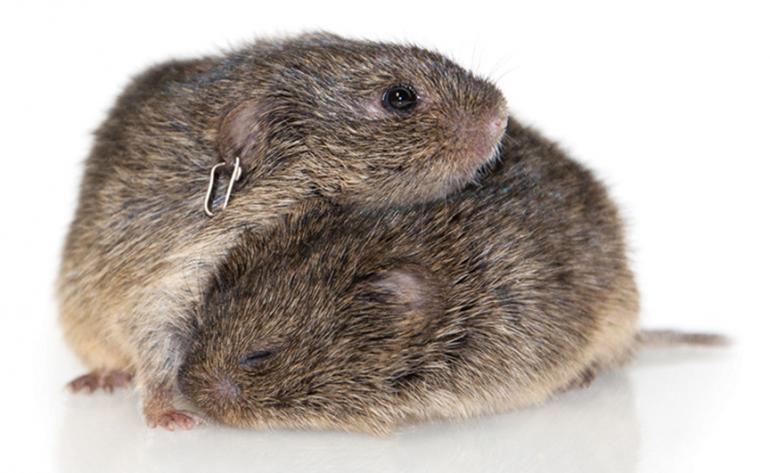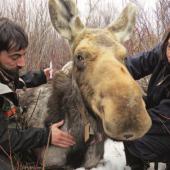Of Mice and Men
Seems we're not so different after all.
When a couple first gets together, they can be pretty obsessed with one another. True love means a long-term commitment, but sometimes there’s cheating on the side. If the couple has kids, in general both parents are involved in raising them. And some guys seem to have a habit of looking for a fight.
Sounds like familiar human behavior, right? What you might see, or at least guess at, if you spent a few hours watching people in, let’s say, a crowded Bozeman bar during happy hour? Incredible as it sounds, these traits have been observed in a two-ounce rodent called the prairie vole.
This little rodent, a resident of Montana and nearby states, is making headlines in the world of neuroscience research because of parallels between its behavior and neurobiology and that of human beings. Although you may never spot one, prairie voles are native to the Bozeman area. They’re rarely seen out in the open, and unless you find evidence of its burrowing or feeding on your vegetation, you’re not likely to be aware of its existence.
University of Wyoming graduate student Kristina Harkins encountered the species by accident while working on her master’s degree in zoology. Harkins researched the life history and distribution of pocket mice, and while live-trapping mice, she and her crew tagged and released over a hundred prairie voles that were drawn to mouse bait. Apparently, they found the mix of horse feed and molasses irresistible.
Harkins discovered first-hand why the prairie vole is known for its assertiveness. “Mice mostly just try to escape when you tag them,” she told me. “Prairie voles seem more aggressive and alert to their surroundings than the mice I handled. They would actually track my hand movements and try to bite my fingers.”
The prairie vole has attracted widespread interest in neurobiology circles as a result of studies at Georgia’s Emory University and other sites on the neurobiology of bonding, cheating, and co-parenting. In “Why do Voles Fall in Love,” a highly entertaining video posted on YouTube, Emory researcher Dr. Larry Young notes that the tiny mammal has effective receptors for vasopressors and oxytocin. Scientists believe that these two hormones are key to the process of bonding between people as well as between prairie voles, and that they form the basis for the vole’s human-like behaviors.
Prairie voles generally mate for life, a rare trait among the world’s animals. The species is “socially monogamous” but not sexually monogamous—in other words, both genders may sometimes cheat on their partners. Knowing Neurons, an educational neuroscience site, tells us that males are known to aggressively defend mate, nest, and territory, a trait that is thought to result from the intense bonding of mated pairs and their shared responsibility for offspring and nest.
Worldwide, there are more than 150 known vole species. Montana alone has eight species. To date, prairie voles are the only known vole with mated couples that groom one another, nest together, share parenting, and cuddle side-by-side whenever they can. Some biologists believe that these traits may be evolutionary adaptations that aid survival in places like central and eastern Montana—open, flat grasslands populated by hungry raptors and other rodent-loving predators.
The prairie vole is a unique little mammal, and it’s not surprising that there have been some unusual studies involving the species—for example, research on behavior after social drinking. In a study where lab voles were offered water laced with alcohol—which they apparently drank quite readily—researchers reported that the sexual behavior of both genders seemed to be affected. Females appeared to be more likely to snuggle with a male acquaintance, while males seemed to be attracted to a fling with a stranger.
The recent Emory study has drawn attention by reporting that prairie voles will “console” others of their own kind. According to Emory’s Dr. Young, when a vole is subjected to stress in the lab, its mate or acquaintance will in effect console it, squeezing close to the other animal, and tenderly licking and grooming it for several minutes. The study suggests that further research involving this species may help scientists to better understand the biochemistry of human emotions, like empathy. It’s possible that prairie-vole research could even point the way to new treatment options for conditions such as autism that can affect a person’s ability to bond and empathize with others.
I asked grad student Kristina Harkins what she thought of the studies of prairie-vole neurobiology. “My experience with this species has involved trying to apply a tag to one of their hairy ears and then releasing them, while at the same time keeping my fingers away from those sharp, orange teeth,” she said. “To me, it’s amazing to think of the contribution that these little guys may end up making to neuroscience research."












